













A mate phoned us recently to rave about a fascinating tourist business he’d just visited. It was the “Spanner Man Sculpture Garden” at Boort in central Victoria. Now, when a bloke goes out of his way to call you about something like this, you know it must be good.
From what we’ve gathered so far, it’s a 2 acre garden to stroll through with many large sculptures made from old, antique spanners. Plus, there are displays of horse drawn mallee farming implements, antique tractors and vehicles and even an art gallery. It sounds like a travelling farmer’s dream with something for men and ladies alike.
Started by the late John Piccoli, it is now run by his son Andrew and Andrew’s wife Janet. It’s open Tuesday to Sunday (closed Mondays), with tours at10.30am to 2.00pm.
We are heading that way soon and it is now definitely on our ‘must-visit’ list.

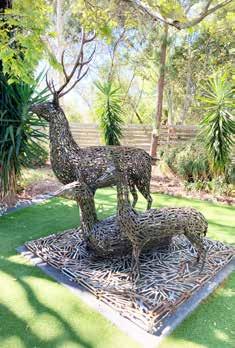
Spanner Man Sculpture Garden
1314 Boort-Quambatook Road, Barraport, Vic. Ph: 0408 932 181
No, we’re not bragging about any personal exploits. Where did your imagination immediately run to…!!?
Let me go on… we have YABBIES in an aquarium in our lounge and THEY have been ‘at it’ all summer long.
One poor female has been constantly egg –laden and to see hundreds of babies hang off her abdomen after hatching is quite a sight. She hunkers down in a protected corner and, interestingly, the male hovers nearby and they actually seem quite lovey-dovey. Their

antennae touch and they are quite gentle with their claws.
Compare that to any usual yabby behaviour, and if one gets anywhere close to another, they shoot off backwards, to avoid conflict and being eaten by the other! Who knew yabbies could actually be quite tender?
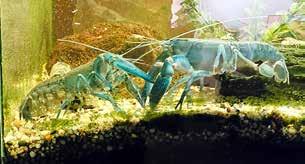
We know it’s been hard for virtually everyone on the land in SA and western Victoria and NSW. Severe drought conditions, low crop prices, high input costs, politicians who don’t listen and not much help around. This is extremely rough for all farming businesses, which includes farm owners, their workers, local businesses and the communities they all live in.
We feel your pain and, like you, we’re riding it out. We’re keeping staff employed, doing long-intended projects, maintenance, tidy ups etc, in between lower than usual shed manufacturing work.
Not only that, we’re continuing
• Our long-term sponsorship of country community sporting clubs
• To publish Farm Gate News because we know that, in just a small way, it also supports our farming families
• To offer farm shed solutions at reduced rates to meet the current market conditions.
Our intention with Farm Gate News has always been to publish an uplifting minimagazine with positive stories and shed news. It’s hoped that the shared stories and ideas (and the much loved Monthly Humour on the back page) may motivate readers, give you a litte reprieve from your day to day worries and give hope with plans for the future.
With that in mind, read on and enjoy this new edition.

Bye now Ali & Danny Halupka Owners - Grant Sheds



Quite some time back, we stopped at Carrieton and popped in to see this historic “Yanyarrie Whim” remains, nearby. It’s a large stone tank with a local slate trough, built in 1853 for watering stock.
The Yanyarrie Whim became a significant watering hole for drovers using the north-south stock route and a stopping place for teamsters on the copper road from Burra to Blinman (SA). Yanyarrie came from the name of the creek running past it and Whim means watering hole.
Carrieton Historic Info:
• In the 1850’s, the Grant family (not related to us) owned the Yanyarrie and Coonatto Runs that exceeded 900 square miles! In 1864 they shore 87,000 sheep but in 1866 they only had 18,000 due to drought.
• In the 1870’s, on the Ragless brothers Yalpara Run, east of Carrieton, they had their own desalination plant to make the well water potable.

• By 1879, Carrieton had a post office, general store and Davies blacksmiths and coach builders that employed 31 men.
• After the droughts of the early 1880’s came the rabbit plague, dust storms, grasshopper plagues, mice plagues and outbreaks of typhoid.
An 80-year-old relative recently dropped in to visit us while driving solo from Darwin to Melbourne to see her son. Known for her determination and mental sharpness, her family had set up phone tracking to monitor her journey.
However, south of Coober Pedy, her phone lost signal, cutting off both communication and tracking. Unfazed, she continued on, spending the night in Quorn before travelling through the Riverland and calling in on us.
Once her phone reconnected, she received a call from SA Police—her family had reported her missing, fearing a medical emergency or accident in the remote
outback. Authorities had shared missing person alerts on social media and were preparing to launch a search aircraft from Adelaide.
This dear lady was surprised by the concern, not realising being out of contact for under 24 hours would spark such a response. Police and family were relieved to find her safe. She had to identify herself at the Berri police station, where Danny, who drove her there, was questioned to verify his identity and relationship to her.
This journey highlighted a few things: not many people would undertake such a trip alone at 80, though she’d likely done it many times before with her late husband. It


also showed how reliant we’ve become on technology—and how vulnerable we are when it fails.
With few phone booths and many rural police stations closed, she hadn’t been able to call. While a roadhouse might have let her use a phone, her independence kept her from asking.
In the end, social media didn’t locate her, but it proved valuable for spreading awareness. A big appreciation too, for the seriousness with which SA Police took the missing person report as it highlights the resources that can be deployed when we need it in the outback.
Thankfully, it all ended well.






Despite the recent tough drought period, the Combe family continue to manage their farming situation for both the short and long terms, by future planning and making shorter term adjustments as needed. Last year was a challenging year, as it was for most farmers throughout the district and South Australia in general.
Each year Phil Combe and his family sit down and plan for the period ahead. Looking at their past results, they envisage the future including what crops they’ll sow over the next 12 months, what machinery they’ll need in the years ahead and what they hope to achieve for the business as a whole. It’s part of a team approach to farming that serves the Combe family well.
Together, Phil and his sons, Cam and Will farm around 6500 acres at Merriton, which is close to Crystal Brook and about two hours north of Adelaide. Phil’s wife Ingrid also helps out with the books, while their daughter Maggie is a radiographer in Port Pirie.
As fith and sixth generation farmers, Phil, Cam and Will grow cereals and lentils and also run sheep. “We’ve cut our numbers back a bit, but we’ve still got about 1200 ewes,” Phil says.
“Mainly lentils is what’s taken off through our

area here, so anywhere you can grow lentils is what we’re trying to do. If you can get that right, it’s hard to beat for gross margins.”
Phil explains the Combe family have been in the Merriton and Crystal Brook areas for about 120 years, and he purchased his farm from an uncle in 1994 after growing up in nearby Laura. “My uncle had four daughters, and he was keen for the property to go back to a Combe, so I got first chance to buy it back,” he says.
In the three decades since, Phil has expanded the business to encompass 6500 acres of which some is leased and some share-farmed. It’s ‘good early country’ with a moderate climate due to proximity to the sea.
“It gets up. It grows and it’s not real frosty,” Phil says. In a normal year, the region enjoys solid rainfall of about 375mm a year, but this past year or so hasn’t exactly been normal. “In the mid north here, we had a shocker last year,” Phil notes. “But we’re probably pretty lucky compared to some, as the three to four years before that were pretty good.”
The Combes aim to produce around 4 t/ ha on cereals and 2 t/ha+ on lentils, as part of a tightly run operation where inputs and outputs are carefully monitored courtesy of solid record keeping and modern technology. Each year, the Combes sit down with their accountants and agronomists, looking at their past results to help predict the future.
“We’ve got about 10 years of benchmarking data , which shows us the history of our strength and weaknesses,” Phil says. These strengths and weak nesses are then used to help with planning, pinpointing where investments might need to be made in terms of upgraded machinery and infrastructure.
Phil notes, with two of his children showing an interest in farming, succession is part of that planning. “I was lucky enough to come down here and start farming at 28, and my boys are getting to a similar age to that now, so we’re looking to get them more and more involved,” Phil says.
Ultimately, he hopes there will be enough land for both of them as well as sufficient housing, and that’s something the family has been actively addressing, with Phil and Ingrid recently building a house in Crystal Brook. “In the three and five year plan, which we’ve just gone through, obviously housing’s an issue for us,” Phil says. “We’ve only got the one farmhouse, which is why we’ve built a house in ‘the Brook’. “We’ve got two boys here so we’re probably also looking to either buy something, or to end up building something on farm if that’s what they want.”
Machinery purchases, upgrades and trade-ins are also part of the ongoing farm plan, in a bid to ensure it is in good condition and can be traded at the optimum time. “We’ve got a bit of a schedule there,” Phil says. “So, you look ahead five or six years and you just try to keep turning something over. Then if you have an above average season, you might want to do something extra.”
Phil notes one of the biggest challenges in recent years has been the lead time required when it comes to purchasing equipment.
“The last couple of years there with COVID and the tax incentives to buy, it’s got to a stage where machinery has been hard to source,” he says. “You had to order machinery 12 months ahead to make sure you would get it now. Some of the air seeders, you could buy them, but they couldn’t build them for two years.”
As part of their ongoing investment in infrastructure, the Combe family recently purchased a 12m x 24m Grant Shed.
Lined with a water and termite resistant, high density, particle board, the shed will serve


a number of purposes, including storing fertiliser, grain and machinery.
Phil notes last year fertiliser proved hard to get out of silos and bins, but the new shed will allow him to store up to 200+ tonnes which can be easily accessed.
It will also serve as a place to store lentils and grain during harvest, while it’s home to the tractor and header between seasons.
Phil says he’d worked with Grant Sheds before, making the decision to go with a Grant shed again easy.
“I saw an article in the ‘Farm Gate News’ and we went with one of the combination sheds that we’d already seen up,” he says.
“I think the quality of the shed’s good and it’s here for a long time to come hopefully.”
“Very professional. Shed was built in 4 days. Excellent workmanship.” Phil Combe, Merriton, near Crystal Brook SA
Meanwhile, Phil and his sons have spent the past couple of months getting ready for what they hope is a better season ahead, conducting maintenance on machinery.
It’s a tight knit team where each person has a role, but all have experience across the different equipment.
“I think it’s important that we can all do everything,” Phil says.
“So everyone can jump on the sprayer or the airseeders or the header or whatever.
“But I also think it’s important that everyone has their own area where it’s his job to maintain or look after that for harvest there.
“Everyone has their roles, but the main thing is we all get on and enjoy it.”

Phil Combe understands the value of future planning for his mid north livestock & cropping

12m x 24m x 5.1m Combination Bulk Fertiliser, Grain & Machinery Shed.
Fully enclosed with 4 sliding doors on one end and sturdy outrigger frames, the doors can be opened beyond the sides of the shed, to give full-end, clear opening.
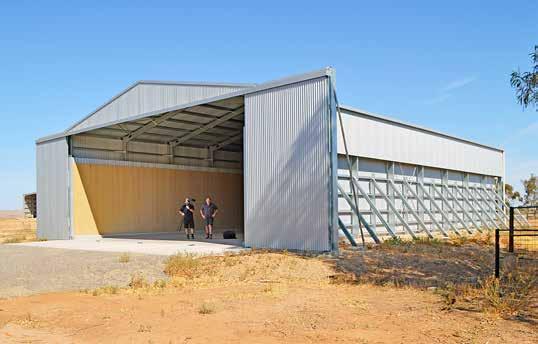
The internal Wesboard Aquatite lining is a termite treated timber lining for shed-safe fertiliser storage. It is further protected by external iron wall cladding.
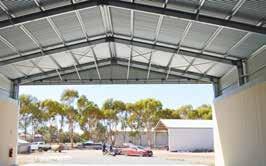
All strength aspects considered.
A. X-bracing in the end bay roof takes pressures through the roof and back to the ground
B. End-truss to purlin stays. These add strength & prevent the gable end pushing in during high winds.
C. Fly braces at every purlin prevent roof trusses twisting

Inside the shed. For highly corrosive fertiliser storage, this Wesboard Aquatite, termite treated, high density particle board is used. Note: We recommend a concrete ‘plinth’ beneath the timber lining.
“It’s a Multi-functional shed to us.”
1. Fertiliser Storage
Save by buying fertiliser when price opportunities arrive
Confidence, knowing you have fert on-farm & ready for sowing
Safety It’s easy and safe to fill & unload (no problem with blockages)
2. Grain & Lentil Storage
Quick & easy storage during harvest prevents harvesting delays caused by weather or off-farm silo issues
3. Machinery Storage
More space for wide equipment with the 12m span
Safe & Secure. Doors create a lockable space to protect against theft.



To our hardworking South Australian farmers, as fellow rural folk, we know the burden you’re carrying right now. The dust, the relentless sun, a sky that refuses to break. It’s exhausting, frustrating, and can be deeply disheartening. But even in the hardest seasons, it’s important to remember that you are not alone.
When the land is dry and rain seems like a distant dream, it’s easy to feel stuck.
One of the best ways to move forward is by investing your time and energy in a meaningful farm infrastructure project. Not only will this give you and your crew a clear, daily purpose, but it will also help build a better future for your farm.
A new shed or workshop isn’t just another expense. It’s an investment that brings practical benefits. For example, a well

“Once in a Blue Moon” Super Shed Sale Hurry - Ends June 30
organised workshop offers a clean, comfortable space to service machinery and make repairs away from the clutter and harsh weather. Imagine working in a space where tools are easy to find, and every job feels a bit simpler and faster. It doesn’t just help today, it benefits your farm for years ahead.
Or consider building a sliding-roof fertiliser shed from Grant Sheds. Building it yourself can save money, and once built, this shed lets you buy fertiliser when prices drop, potentially saving thousands of dollars over time. And unlike silos, these sheds offer safer storage, lowering risks on your farm.
When things feel overwhelming, keeping your hands and mind busy on a constructive project helps you fight off feelings of helplessness a drought can bring. Having clear goals each day brings a sense of purpose, not to mention the pride you feel when the job is done. It reminds you and
One person can roll the roof open easily in just a few minutes. Shed can also be used for fodder, grain & small vehicle or implement storage

7.5m x 9m x

Shown above in closed roof positions & with optional swing doors & bottom right in open-roof position. Available 9m, 12m or 15m long.
“It definitely saves us a few quid… and it’s convenient. Now we buy fertiliser when we get a good deal, put it in this bunker and use it when we like, knowing it’ll be in good condition. We store other items like wool, or feed grain too.
Damien
Florance, Kangaroo Island SA

TAX
Still applies on sheds for fodder storage. *Conditions Apply: Seek your independentown advice.
your team that even in tough times, progress is possible.
We know droughts can feel endless, but history shows they do eventually break. Your determination and ability to adapt are what carry you through. Starting a project now means you’ll be better prepared and ready when the rains arrive.
Stay strong. The rain will come again, and when it does, you’ll be ready.
We are, as Dorothea Mackellar told us, “A land of droughts and flooding rains.”
Ain’t that the truth at the moment. Cyclones and floods in Queensland. Drought in South Australia & Victoria.
Remember, each day brings us closer to the rain we all want here. Meanwhile, have a look at these great farm shed ideas.

Future-proofing the farm: Hay fodder for their pigs and sheep livestock is protected in this Grant Sheds Super-C shed.
12m x 24.3m x 6m Hay Shed with 3 x 8.1m wide beams, ideal for large bale storage. UB front intermediate columns to avoid damage when loading. Bale bumper rails prevent iron damage on rear wall.
“A strong, well designed, easily erected shed (smart). We really didn’t look anywhere else. It was a case of ring Grant’s and get a price.” Lyndon & Brian ’Rowdy’ Hampel, Nadda Farms via Loxton SA


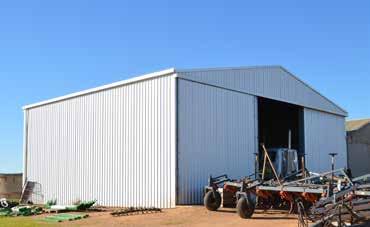
Sliding doors on the gable end.
Mildy Chandler at Penong on the far west of Eyre Peninsula has 7 Grant sheds, including this farm workshop which was his 5th and he often says, “I should have started with this one.” Living near the coast, there are a lot of windy days and he says it’s good to be able to go in the shed and still do productive maintenance or farm welding work.
And about his machinery sheds he says, “If you’ve got equipment, it’s got to be in a shed and I’ve had a good experience with Grant Sheds in the past so it was every reason why I’d buy another one. It’s a good product.”
Options & Ideas: This shed can be supplied with outrigger frames so the sliding doors can be fully opened to the full width of the shed, giving better access for wide implements.
2 x9m wide beams on the front, Bale bumper rails on the rear wall, UB front intermediate columns
This is Andy Withers most recently built hay shed on his beef grazing and stud cattle property, when it was just completed. Last Christmas he sent us a beaut note:
“Thank you Ali and Danny and Merry Christmas and all the best for the New Year to you and your family too.
My last 3 Grant sheds get worked in or are storing rather expensive hay right now. I need to fill them with a bit more hay but it’s shorter and more expensive than usual. All the more reason to keep it under cover.”
Cheers… Andy Withers, Exmoor Grazing Co, Naracoorte SA (December 2024)
100% TAX DEDUCTION
Still applies on sheds for fodder storage, including hay & grain sheds. *Conditions Apply.

Rebates up to $20,000 for primary producers who implement infrastructure projects that assist with managing current drought conditions and strengthen preparedness for future droughts. Eligible activities include grain & fodder storage (eg. Grain & hay sheds)
This makes NOW an Exceptional Time to invest in your next shed.
*Conditions Apply: See here for more info www.pir.sa.gov.au/funding/ on-farm _drought_infrastructure_rebate_scheme
FODDER-HAY SHED OR MACHINERY SHED


“Once in a Blue Moon” Super Shed Sale Hurry - Ends June 30

Plus, get 100% immediate Tax Deduction on sheds used for fodder storage...AND... SA/Vic farmers, you
The sooner you order, the more you SAVE!
Once in a Blue Moon & EARLY BIRD SAVINGS
SAVE on your NEW SHED!
Up to $20,000 off*
SAVE on BUILDING*
Up to 10% discount
SAVE on DELIVERY*
REASONS To Act FAST Order by 30/4/25
Rare EOFY Sale provides more relief for farmers when you order before 30th June 2025. Discounts apply on most sheds. Inquire Now!
Get up to 10% OFF shed building costs when you order before 31st May 2025
Even better... Also Slash up to $2000* OFF delivery costs when you order before 30th April 2025 3 3 3 X 3 X X 3 3 1 2 3
Up to $2000 off
Yesterday I accidentally passed my wife a glue stick instead of her lipstick. She’s still not talking to me! I started reading a book about the history of glue. Now I can’t put it down. My wife refuses to confess that she poured glue on my antique weapons collection.
But I’m sticking to my guns!
TRAGEDY AT WORKPLACE MAN DIES AFTER FALLING INTO GIANT COFFEE VAT
Was this a problem for our recent Federal election?
7 Rules of Life
1. Make peace with your past So it won’t disturb your present 2. What other people think of you is none of your business
3. Time heals almost everything Give it time
4. No one is in charge of your happiness except you
5. Don’t compare your life to others And don’t judge them. You have no idea what their journey is about 6. Stop thinking too much It’s alright not not know the answers yet
7. Smile
You don’t own all the problems in the world

His wife told reporters:‘He didn’t suffer. It was instant’.

My next door neighbour knocked on my door wearing just a see through negligee, asked to borrow a cup of sugar and then winked at me and asked to come in for a coffee. I said … “F**k off Davo, I’ve got to go to work!”

The cow didn’t make it! Joke provided by our 9 year old grandson Logan What did scientists prove when they found bones on the moon?